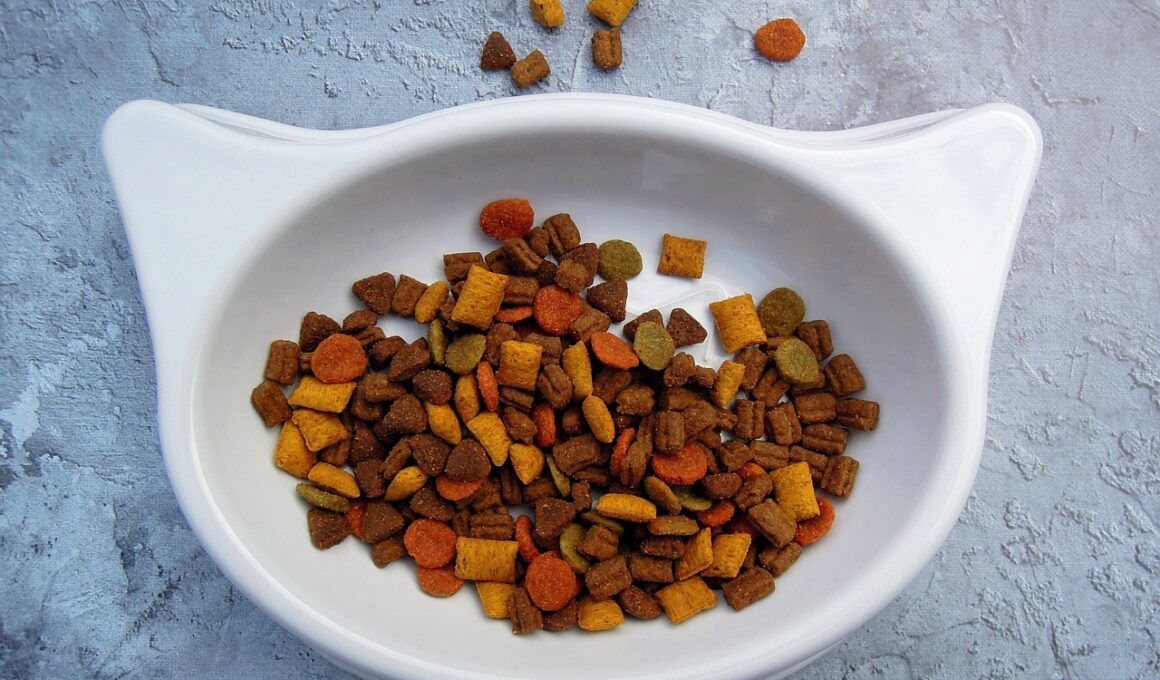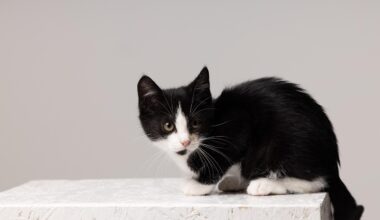Innovative Ways to Store Bulk Cat Food at Home
Keeping your cat’s food fresh and safe is crucial for their health and wellbeing. Proper storage helps prevent spoilage and contamination, ensuring that your feline friend enjoys every meal. Begin by choosing the right containers to store bulk cat food. Look for airtight, food-grade storage bins with a secure seal to prevent moisture and pests from accessing the food. It’s important to keep these containers clean and free from residues that could attract unwanted critters. Regularly inspect your storage area, ensuring it’s cool and dry to maintain the food’s quality. Don’t forget about labeling! Use a permanent marker or labels to indicate the food type and purchase date, helping you easily manage your supplies. Consider the size of your bins to align with your cat’s eating habits, refilling smaller containers as needed. In addition, avoid mixing different types of cat food, such as dry and wet, as they have unique storage needs. By taking these steps, you can create a practical system to keep your cat’s food organized, fresh, and ready for mealtime.
Most cat owners buy cat food in bulk to save on costs, but storing it safely is essential. Utilize designated storage cabinets or shelves in your home dedicated to pet supplies. This not only keeps your cat food organized but also extends its shelf life. If you’re limited in space, consider stacking bins that can easily fit into tight spots, ensuring you select containers that are durable and easy to clean. Always place the freshest food at the back of the storage area and older food in front, following a first-in, first-out system. This principle allows your cat to consume food before it becomes stale. Additionally, it’s wise to keep the food away from direct sunlight, heat sources, or humidity to prevent spoilage. You might also want to include desiccants in your storage bins to absorb moisture, ensuring optimal storage conditions. These simple adjustments can significantly contribute to the longevity of the food. Lastly, remember that some cats may prefer their food a bit warm; if yours does, allow for a bit of time to bring it to a comfortable temperature after storage.
Creative Cat Food Storage Solutions
Be inventive with your storage by utilizing space creatively. Repurposing household items can be both practical and economical. For instance, old craft containers or glass jars with secure lids can effectively store cat food. Not only do these containers save space, but they also give you an opportunity to decorate them, making them a part of your home decor. If you have a larger stock of food, investing in a vacuum-sealed container could be beneficial. These containers eliminate air, which can cause food to go stale faster. Furthermore, consider your pet’s feeding routine. If you have multiple cats or different food types, it might be advantageous to have a separate bin for each variety. This minimizes confusion and helps maintain a consistent feeding schedule. Always remember to place your storage solutions in a location that is high enough to avoid curious paws, ensuring that your cat cannot access the containers independently. Incorporating these creative solutions keeps your storage functional while enhancing your home environment.
Another essential tip is to maintain a regular cleaning routine for your storage area. Mold, dust, and insect debris can accumulate, posing risks to food safety. Schedule a thorough cleaning every few weeks and inspect for any signs of pests or spoilage. Using a vacuum cleaner or damp cloth to clean surfaces can help maintain cleanliness. If you notice any signs of moisture or insects in your cat food, it may be best to discard that batch. It’s better to be safe than sorry! When purchasing cat food, opt for reputable brands that emphasize quality and safety. Read the labels ensuring no fillers or artificial ingredients are present, as these can impact your cat’s health. Store the food according to label instructions and recommend using smaller containers for day-to-day use. This minimizes exposure to air and light while the larger stock remains sealed and protected. Cat owners should also create a designated feeding area that encourages routine feeding times, establishing a comforting environment for their pets. Following these recommendations allows you to ensure the utmost safety and quality for your beloved companions.
Managing Bulk Purchases Efficiently
While storing bulk cat food efficiently is crucial, managing your purchasing habits is also important. Always keep a detailed inventory of your supplies, preventing over-purchasing and waste. Create a list of your cat’s preferences and needs with abbreviations, ensuring an organized approach while shopping. You may want to take advantage of sales or promotions that bulk cat food suppliers often offer, but always calculate if you can realistically use that amount before its expiration date. Additionally, consider joining a community or forming a group buy with friends or neighbors to purchase in larger quantities while sharing the cost. This strategy may save money while ensuring you have a stockpile that won’t go waste. Look for locally produced options or buy online, as many brands offer subscription services tailored to your needs. Outdoor cats or those on special diets may have varying food requirements, so tailor your purchases accordingly. Managing bulk purchases efficiently not only saves you money but also ensures you provide high-quality nutrition for your feline friend.
When it comes to DIY storage solutions for your cat food, whimsical ideas can transform your storage space into something special. Crafting personalized containers can be a fun afternoon project. You could paint or label bins specifically for cat food, allowing them not only to stand out but also to become a focal point in your home. Use materials like chalkboard paint for versatile labeling; you can easily update contents as needed. You could also create a wall-mounted storage system for your bins, which saves space and makes feeding time accessible. Always remember to involve the whole family in the organization process, which can foster a sense of responsibility in children regarding pet care. Additionally, your cats may enjoy having a feeding station specifically tailored to their preferences; consider adjustable feeding heights or a decorative theme to match your home style. Making cat food storage a creative and collaborative task keeps it organized and efficient, mirroring the thought and care that’s invested in your pet’s nutrition. Finally, ensure transparency in your storage efforts so that anyone in the household knows where to find the cat food.
Final Thoughts on Cat Food Storage
Ultimately, providing optimal storage for your cat’s food is a key element of responsible pet ownership. Not only does it protect the food from spoilage and pests, but it also demonstrates your commitment to your pet’s health. Applying these innovative storage techniques and maintaining cleanliness can luxury living for your beloved cats while saving money. Always ensure that your storage systems align with your household dynamics, catering to the needs of your furry companions. As you experiment with space-saving solutions and unique ideas, keep your cat’s preferences at the forefront of your storage adventures. Creativity can enhance the experience, making the mundane task of food storage into an engaging project. If ever in doubt, consult with vets or pet nutritionists for personalized advice on storing and feeding based on your cat’s diet. By paying close attention to these details, you can develop a safe, organized, and visually pleasing system that makes feeding time enjoyable for both you and your cat. In conclusion, storing bulk cat food with care reflects a broader commitment to nurturing the bonds between you and your furry friend.
Educated decisions regarding your storage choices have long-term benefits for your cat’s health.


